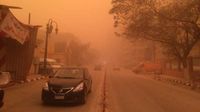A recent study led by Galen Kenny, a professor of physiology and director of the Human and Environmental Physiology Research Unit at the university, has raised alarms about the human body's ability to cope with extreme heat and humidity. The research team subjected 12 volunteers to extreme laboratory conditions, where temperatures reached a staggering 42 degrees Celsius (approximately 107.6 degrees Fahrenheit) with 57% humidity, simulating an outdoor heat index of nearly 62 degrees Celsius (about 143.6 degrees Fahrenheit). The results were startling, revealing that these conditions were sufficient to disrupt the volunteers' natural cooling systems.
Within just a few hours, the internal body temperatures of the participants began to rise uncontrollably, leading to dehydration and forcing most to withdraw from the nine-hour experiment before completion. Kenny remarked, "We have made a dangerous mistake in our understanding of human physiology, as the data shows that our bodies begin to fail at much lower heat and humidity levels than we previously thought." This statement underscores the critical implications of the findings, which suggest that current thresholds for heat-related illnesses may need reevaluation.
The experiment unveiled a concerning mechanism: when heat and humidity exceed certain thresholds, the body’s cooling system fails. The skin becomes a closed surface that prevents sweat from evaporating, leading to a slow internal overheating. This revelation has prompted scientists to call for urgent action, advocating for the redesign of urban spaces to incorporate green areas that can reflect heat, the development of more efficient air conditioning systems, and the establishment of cooling shelters in neighborhoods.
More importantly, these findings serve as a stark reminder that climate change is not merely a series of statistics but a direct threat to biological survival. As global temperatures continue to rise, the ability of human bodies to cope with extreme weather conditions is increasingly compromised.
In a related development, a severe sandstorm has struck parts of Egypt, particularly affecting Aswan, leading to the closure of river navigation and a heightened state of emergency. Dr. Ismail Kamal, the governor of Aswan, has raised the preparedness level to deal with these weather changes. Authorities have suspended all river traffic on the Nile and Lake Nasser due to strong winds carrying sand and dust, which have significantly reduced visibility.
In light of the sandstorm, the governor emphasized the importance of continuous monitoring through the national emergency network and local operations rooms to ensure swift responses to any emergencies. Engineer Sami Al-Barbari, head of the Nile River Navigation Authority in Aswan, confirmed that all maritime activities, including floating hotels and Nile boats, have been halted until weather conditions improve. He urged all vessels to exercise extreme caution when navigating.
This sandstorm comes amidst forecasts predicting a strong climatic disturbance that could affect the area for several days. The General Authority for Meteorology has announced that from April 2 to April 7, 2025, temperatures will rise across Greater Cairo, the Delta region, the eastern coasts, and northern Upper Egypt. Meanwhile, the western coasts will experience hot conditions, and southern Sinai and Upper Egypt are expected to see very high temperatures.
As night falls, a noticeable drop in temperatures is anticipated across most regions, with sandstorms likely to occur in scattered areas over the weekend. The authority has urged citizens to take necessary precautions to mitigate the impacts of these weather phenomena.
Given these two significant events—Kenny's alarming research on human physiology in extreme heat and the current sandstorm in Egypt—it is evident that climate change poses a multifaceted threat. The implications of Kenny's study highlight the need for immediate adaptations in urban planning and public health strategies, while the sandstorm underscores the urgency of preparedness for extreme weather events.
As communities grapple with these challenges, the intersection of health, urban design, and climate resilience becomes increasingly critical. The call for green urban spaces and effective cooling solutions is not just about comfort; it’s about survival in a rapidly changing climate.
In conclusion, the convergence of scientific research and real-world weather events paints a concerning picture of our future. As temperatures soar and extreme weather becomes more frequent, understanding the limits of human physiology and preparing our environments to withstand these changes is essential.






